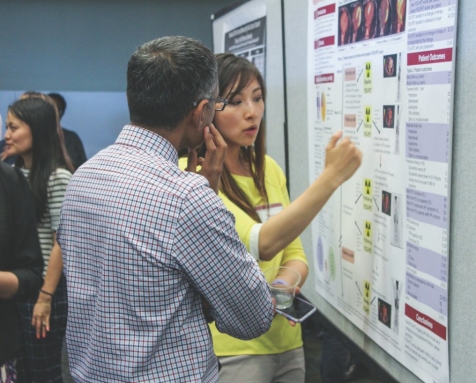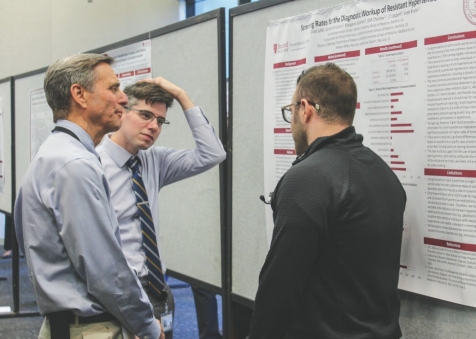
MAGGIE NING, MD, presents her work to SHRIRAM NALLAMSHETTY, MD.
Conference Showcases Residency Research

MAGGIE NING, MD, presents her work to SHRIRAM NALLAMSHETTY, MD.
Conference Showcases Residency Research
Wearing a black Stanford Medicine fleece over his blue scrubs, third-year internal medicine resident Gilad Jaffe, MD, stood in front of a poster that described his research on screening rates for primary aldosteronism in patients with resistant hypertension.
He shared the specifics of his findings with a roomful of attendees at the first-ever Stanford Medicine Residency Research Symposium.
Jaffe was one of 49 residents who participated in the event, which was designed to “highlight the remarkable things our residents are doing,” says Angela Rogers, MD, an assistant professor of pulmonary and critical care medicine and the associate program director of the Stanford Internal Medicine Residency Program, who oversaw the symposium.
“More than 80 percent of Stanford residents take a dedicated research month during their time here,” she explains, “and they are amazingly productive. The amount of work and research that they do on their nights and weekends is worth celebrating.”
Resident Jimmy Tooley, MD, one of the leaders of the Stanford Internal Medicine Research Interest Group who helped organize the event, agreed with Rogers, adding: “There is a lot of great mentorship and research going on. I am so impressed and inspired by all the amazing work being done by my peers.”
During the event, faculty judges, mentors, and fellow residents walked up and down several aisles of poster boards, pausing to ask questions, give insights and feedback, and take notes.
The projects on display spanned disciplines, fields, and diseases — investigating topics ranging from advanced care planning to complications of cirrhosis. “Essentially every specialty within medicine was represented,” recalls Rogers. “It was an opportunity for residents to show each other their work, and there aren’t a lot of avenues for that.”
It was also an opportunity to highlight the important role that mentorship and guidance play throughout the Stanford residency experience. “The projects that were presented involved 25 mentors — it’s a testament to how many faculty give their time,” says Rogers. “This type of long-term relationship with a single mentor can be instrumental, and it’s something we pride ourselves on.”
Jaffe has seen the benefits of this long-term mentorship firsthand. He’s been working alongside his mentor, Vivek Bhalla, MD, an assistant professor of nephrology, since the start of his intern year in 2016. “Dr. Bhalla is an outstanding teacher, mentor, and physician,” Jaffe explains. “He is extremely supportive of me and my goals. He worked with me closely and guided me through the process, but also gave me room to spread my wings and figure out the research landscape. He always made time for our research, even if it meant talking to him on his personal time at home.”
At the end of the event, the judges picked 10 winners who received small monetary prizes, but it was clear from the palpable energy and excitement in the room that it was a valuable experience for all involved. “It was spectacularly successful, and we plan to host it every year,” Rogers confirms. “The enthusiastic response from residents and faculty made the event celebratory and supportive.”

From left: DAVID MARON, MD, and ALEXANDER PERINO, MD, ask GILAD JAFFE, MD, about his research poster
Wearing a black Stanford Medicine fleece over his blue scrubs, third-year internal medicine resident Gilad Jaffe, MD, stood in front of a poster that described his research on screening rates for primary aldosteronism in patients with resistant hypertension.
He shared the specifics of his findings with a roomful of attendees at the first-ever Stanford Medicine Residency Research Symposium.
Jaffe was one of 49 residents who participated in the event, which was designed to “highlight the remarkable things our residents are doing,” says Angela Rogers, MD, an assistant professor of pulmonary and critical care medicine and the associate program director of the Stanford Internal Medicine Residency Program, who oversaw the symposium.
“More than 80 percent of Stanford residents take a dedicated research month during their time here,” she explains, “and they are amazingly productive. The amount of work and research that they do on their nights and weekends is worth celebrating.”
Resident Jimmy Tooley, MD, one of the leaders of the Stanford Internal Medicine Research Interest Group who helped organize the event, agreed with Rogers, adding: “There is a lot of great mentorship and research going on. I am so impressed and inspired by all the amazing work being done by my peers.”
During the event, faculty judges, mentors, and fellow residents walked up and down several aisles of poster boards, pausing to ask questions, give insights and feedback, and take notes.

From left: DAVID MARON, MD, and ALEXANDER PERINO, MD, ask GILAD JAFFE, MD, about his research poster
The projects on display spanned disciplines, fields, and diseases — investigating topics ranging from advanced care planning to complications of cirrhosis. “Essentially every specialty within medicine was represented,” recalls Rogers. “It was an opportunity for residents to show each other their work, and there aren’t a lot of avenues for that.”
It was also an opportunity to highlight the important role that mentorship and guidance play throughout the Stanford residency experience. “The projects that were presented involved 25 mentors — it’s a testament to how many faculty give their time,” says Rogers. “This type of long-term relationship with a single mentor can be instrumental, and it’s something we pride ourselves on.”
Jaffe has seen the benefits of this long-term mentorship firsthand. He’s been working alongside his mentor, Vivek Bhalla, MD, an assistant professor of nephrology, since the start of his intern year in 2016. “Dr. Bhalla is an outstanding teacher, mentor, and physician,” Jaffe explains. “He is extremely supportive of me and my goals. He worked with me closely and guided me through the process, but also gave me room to spread my wings and figure out the research landscape. He always made time for our research, even if it meant talking to him on his personal time at home.”
At the end of the event, the judges picked 10 winners who received small monetary prizes, but it was clear from the palpable energy and excitement in the room that it was a valuable experience for all involved. “It was spectacularly successful, and we plan to host it every year,” Rogers confirms. “The enthusiastic response from residents and faculty made the event celebratory and supportive.”
